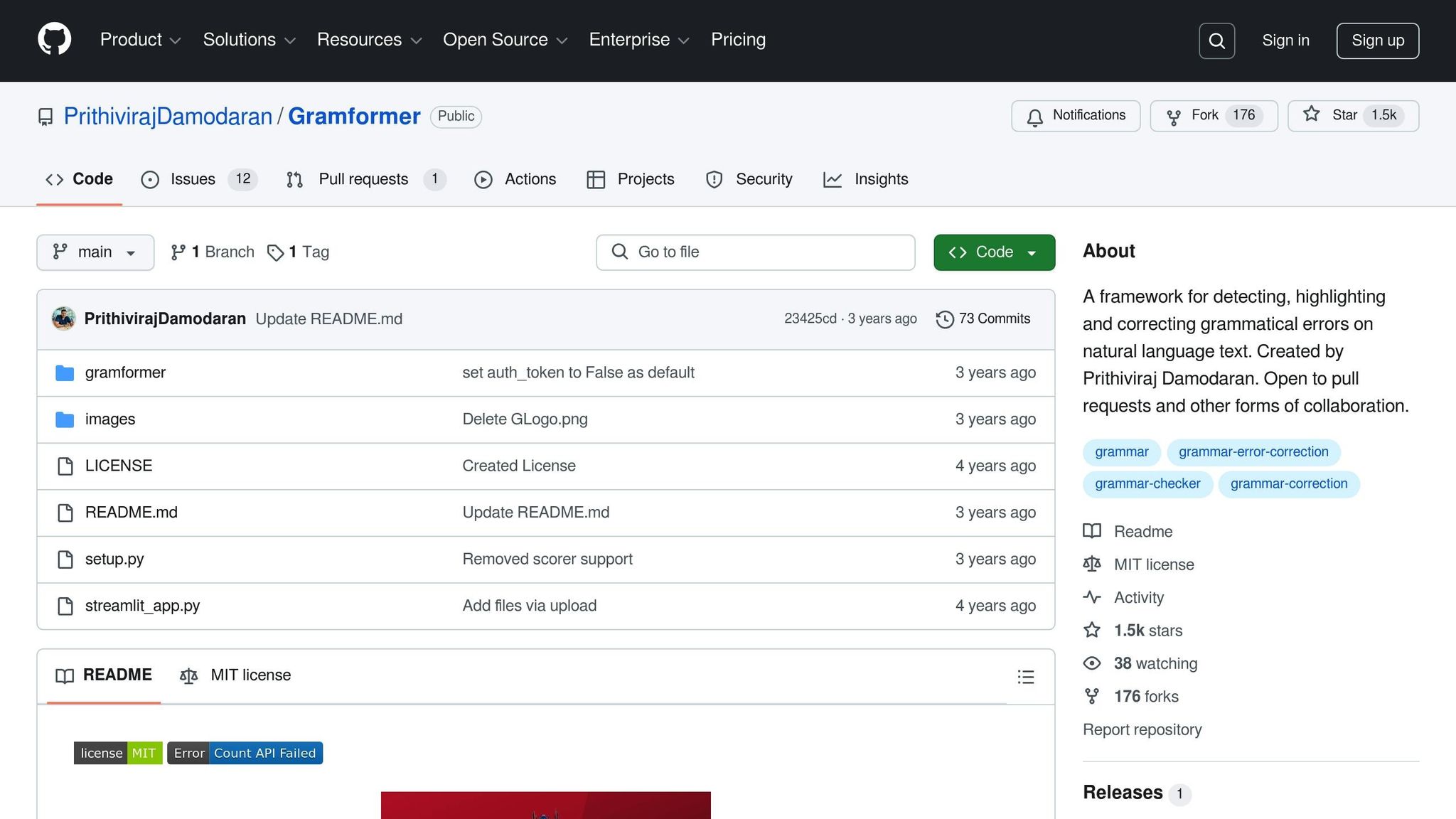How Context-Sensitive Grammar Correction Works
Context sensitive grammar correction improves writing by analyzing the entire sentence and understanding word meanings based on their context. This approach ensures accurate suggestions that match your intent, tone, and style. Here’s what you need to know:
- What It Does: Fixes grammar mistakes by considering the sentence’s context, like distinguishing between “affect” and “effect” or “bank” (financial institution) vs “bank” (riverbank).
- How It Works: Uses AI and machine learning to understand syntax, tone, and word relationships. It’s trained on large datasets to handle nuances in U.S. English.
- Key Benefits: Saves time, improves accuracy, and adapts to different writing styles (e.g., formal emails or casual messages).
- Limitations: May struggle with vague input, large texts, or specific character and correction limits based on subscription tiers.
Core Elements of Context Sensitive Grammar
Context Sensitive Grammar Basics
Context Sensitive Grammar (CSG) focuses on how words and phrases interact within a sentence, rather than analyzing them in isolation. This approach helps determine meaning and intent. For instance, in the sentence “The bank is close to the river”, a CSG system can figure out whether “bank” means a financial institution or a riverbank by considering the surrounding words and overall context. This method is key to powering advanced writing tools.
Using CSG in Language Processing
BeLikeNative leverages CSG to improve both accuracy and tone in writing. It offers suggestions tailored to your intended meaning and tone. According to top users of BeLikeNative, this approach has led to a 66% increase in productivity. Up next, we’ll break down the algorithms that make these corrections possible.
Technical Process Behind Context Sensitive Grammar Correction
How Text Is Analyzed
The system first breaks down the text into smaller components, or tokens, and then examines how these parts relate to each other. For instance, in the sentence “Their going to the store”, it identifies the verb phrase “going to” and recognizes that “their” should be corrected to “they’re.” It uses this understanding of syntax and meaning to propose accurate corrections.
Role of AI in Language Processing
AI models play a key role by encoding the text, identifying the language, and analyzing its context, tone, and style. These machine-learning models are trained on large datasets that include annotated examples, enabling them to offer context-aware corrections. They are specifically fine-tuned to handle the nuances of U.S. English.
Examples of U.S. English Context Sensitive Grammar Rules
The system handles tricky grammar rules like distinguishing between homophones (e.g., choosing “affects” over “effects” when appropriate) and ensuring subject-verb agreement (e.g., treating “group” as singular even when followed by plural nouns). These adjustments ensure the text aligns with standard U.S. English conventions.
Benefits and Limits of Context Sensitive Grammar Correction
Main Benefits
Context-sensitive correction offers highly accurate suggestions while saving over 85 hours each month.
- Identifies and fixes errors in complex sentence structures
- Distinguishes between similar words based on their usage
- Works seamlessly with the clipboard and keyboard shortcuts for easy integration
Current Limits
While the system utilizes advanced token analysis and AI models (see “Technical Process”), it does come with some challenges:
- Processing large texts can slow down due to high computational demands
- Accuracy drops when dealing with vague or unclear input
- Usage is limited by character caps (1,000 to 10,000) and daily allowances (25 to 180 corrections), depending on your subscription tier [2]
These limitations are a result of the sophisticated AI processes powering the tool.
Next: Learn how to set up BeLikeNative and incorporate context-sensitive correction into your workflow.
sbb-itb-32359dc
Gramformer: Context Sensitive Grammar Correction With a Transformer Model (NLP)

Using Context Sensitive Grammar Correction Tools Effectively
To make the most of context-sensitive corrections, adjust BeLikeNative’s language settings and connect it with your preferred writing tools.
Language Options and Settings
BeLikeNative supports more than 80 languages. This allows you to customize tone and style, whether you’re drafting a formal email or a casual message. These settings help ensure suggestions align with your intended meaning and audience.
Integrating Tools into Your Workflow
Refine your text effortlessly using the clipboard shortcut in apps like WhatsApp Web, Google Docs, Microsoft Teams, Notion, and Evernote Web. This approach can increase efficiency by up to 66%.
Getting the Most Out of BeLikeNative

Top users save over 85 hours each month by using BeLikeNative effectively. Choose the plan that matches your needs: daily corrections range from 25 (Explorer) to 180 (Premium), while character limits vary from 1,000 to 10,000.
Conclusion
Context-sensitive grammar correction improves both accuracy and efficiency by understanding the context of text to provide precise suggestions. This approach has been shown to boost productivity by 66% and save up to 85 hours per month. Tools like BeLikeNative highlight this capability, offering support for over 80 languages and integration with platforms like Google products, Notion, and Microsoft Teams.
As AI and natural language processing continue to evolve, these tools will become even better at analyzing context and delivering accurate suggestions, making them a key part of modern writing workflows.



14 Comments
MyBlog
August 14, 202512:19 pm
itstitle
excerptsa
acheter kamagra vendre acheter
August 17, 20258:40 am
acheter kamagra achat
est kamagra au comptoir en allemagne
order enclomiphene buy in london
August 17, 20259:28 am
how to get a doctor to prescribe enclomiphene
order enclomiphene generic no prescription
ordering androxal where to purchase
August 17, 202510:25 am
cheap androxal generic mastercard
get androxal cheap prescription
how to buy flexeril cyclobenzaprine australia cheap
August 17, 202512:47 pm
how to buy flexeril cyclobenzaprine buy online no prescription
buy cheap flexeril cyclobenzaprine uk online
generic dutasteride canada online
August 17, 20251:00 pm
buying dutasteride generic canada
cheap dutasteride sales
cheap gabapentin buy dallas
August 17, 20253:23 pm
purchase gabapentin price usa
order gabapentin usa seller
online order itraconazole generic from the uk
August 17, 20254:06 pm
best pharmacy price for itraconazole
buy cheap itraconazole price uk
purchase fildena cheap from canada
August 17, 20254:27 pm
buy cheap fildena generic best price
how to buy fildena with out a perscription
how to buy staxyn usa generic
August 18, 20252:21 am
cheap staxyn generic uk
cheap staxyn cheap online canada
online order avodart cheap mastercard
August 18, 20253:37 am
get avodart using mastercard
how to order avodart purchase online safely
discount rifaximin cheap store
August 18, 20256:04 am
rifaximin prescriptions
ordering rifaximin without rx online
xifaxan no dr
August 18, 20257:14 am
get xifaxan generic medications
generic xifaxan capsules price comparison
kamagra hong kong kde koupit
August 18, 20258:37 am
jak to zvládnout bez kamagra
en las farmacias simi puedo comprar kamagra
Comments are closed.